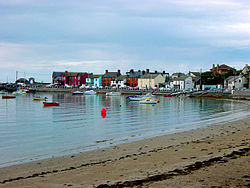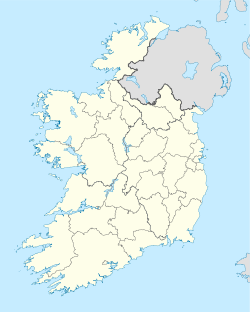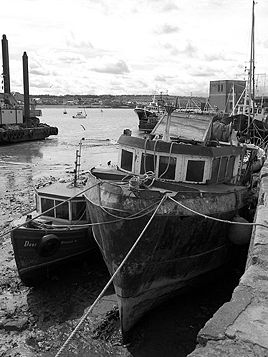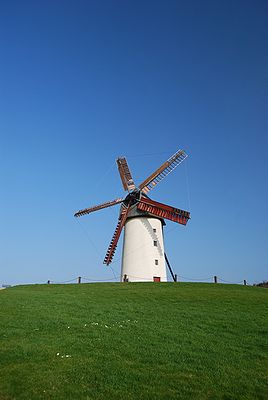- Skerries, Dublin
-
Skerries
Na Sceirí— Town — Brightly painted houses at Skerries harbour Location in Ireland Coordinates: 53°34′58″N 6°06′30″W / 53.5828°N 6.1083°WCoordinates: 53°34′58″N 6°06′30″W / 53.5828°N 6.1083°W Country Ireland Province Leinster County Fingal Elevation 5 m (16 ft) Population (2011)[1] – Urban 8,344 Irish Grid Reference O248606 Skerries (Irish: Na Sceirí, meaning "(The Rocks") is a seaside town in North County Dublin, Ireland, now part of County Fingal. The name comes from the Norse word Skere which has descended into the Irish word ¨Na Sceiri¨ which means ¨The Rocks.¨
Contents
Geography
Skerries has five islands off its coast. These are Shenick Island, St Patrick's, Colt and Rockabill. Rockabill is in fact two islands, "The Cow" and "The Calf", [2] separated by a narrow channel. There is also Red Island, which is a tied island. The town itself is built around two long streets - Strand Street and Church Street and between the surrounding hills of North Fingal and low-lying beaches. Red Island, Mill Hill, Hillside, The public Ardgillan Park and Demesne, Barnageera and to a lesser extent Baldungan Castle are high points on which you can look over the town.
Rockabill has the largest numbers of breeding Roseate Terns in Europe. It is also the farthest away from the town and has a lighthouse. On Shenick Island can be found a Martello tower, one of a number of defensive towers erected during the Napoleonic era along the Irish coast by the British. Shenick is accessible on foot at the lowest tides, but this is inadvisable, due to the relatively rapid fill caused by the turning tide. The other islands are harder to reach, but it is possible by boat. Red Island also has a Martello Tower. St Patrick's Island is so called because this is where the Irish patron saint is reputed to have landed and begun his mission to convert the country to Christianity.
History
Early writers tell how an island off Skerries was used as a landing place for an invasion, which happened in the second century. This island was either Shenick or Red Island, which would have been a tidal island at the time. When the invaders landed, they formed ranks and at low tide marched to the mainland, where they were promptly defeated at the ancient settlement of Knocknagin, north of Balbriggan. The islands were previously known as the Islands of Cor possibly after the original inhabitants.
As noted, in 432 AD, St. Patrick is reputed to have landed on Church Island, and according to the Annals of Inisfallen Saint Mochonna founded a monastery shortly afterwards.
In the year 797 AD, the Danes carried out one of their earliest raids in Ireland when they plundered the monastery on Church Island. As the origin of the name is Norse and many localities have Norse-based names, it is safe to assume the Vikings did settle and occupy the area. Sitric, who was a son of a Dane called Murchard, re-founded the monastery on Church Island in 1120. He dedicated it to St. Patrick, the Apostle of Ireland. By this time the Danes who had settled in Ireland had become Christians.
In 1148 Saint Malachy, Archbishop of Armagh, arranged a synod on St. Patrick's island to settle differences between the Irish Christians and the Pope. Fifteen bishops, two hundred priests and other clergy were present.
In 1496 the King gave permission to the Prior of Holmpatrick to build a pier. At this time Skerries was the property of the monastery of Holmpatrick and was known as the Port of Holmpatrick.
In 1565, after the Reformation, the monastery and its lands became the property of Thomas Fitzpatrick. In 1605 the manor and lands of Holmpatrick was granted to the Earl of Thomand. In 1721 the last Earl sold the manor and lands, including the town of Skerries, to the Hamilton family of Hacketstown.
In 1897 the Hamilton family were granted the title of Lord Holmpatrick. Comparisons between maps of Skerries drawn in 1703 and 1760 suggest that the Hamilton family was responsible for setting out the streets of the town as they are today. Between 1863 and 1865 a monument to the memory of James Hans Hamilton, the local landlord and MP, was erected in Skerries. The Monument is a reduced scale replica of the Wellington Monument in the Phoenix Park, Dublin. It is now at the heart of the commercial centre of the town.
After the 1916 rising, a British Destroyer landed troops at Skerries to help the Dublin garrisons suppress the rising. 200 men of the North Staffordshire Regiment landed under the command of Captain Clay. To try and impede their progress to Dublin, local rebels blew up the bridge over the railway in Donabate.
Historical populations Year Pop. ±% 1813 — 1821 2,272 — 1831 2,556 +12.5% 1841 2,519 −1.4% 1851 2,327 −7.6% 1861 2,257 −3.0% 1871 2,236 −0.9% 1881 2,227 −0.4% 1891 1,809 −18.8% 1901 1,721 −4.9% 1911 1,936 +12.5% 1926 1,973 +1.9% 1936 2,134 +8.2% 1946 2,305 +8.0% 1951 2,457 +6.6% 1956 2,450 −0.3% 1961 2,721 +11.1% 1966 2,893 +6.3% 1971 3,044 +5.2% 1981 5,793 +90.3% 1986 6,864 +18.5% 1991 7,032 +2.4% 1996 7,339 +4.4% 2002 9,149 +24.7% 2006 8,175 −10.6% 2011 8,344 +2.1% The 20th century and today
Historically, Skerries has been a thriving fishing port and a major center of hand embroidery. In the late 20th century, it became a resort town (golf, sailing, motorcycling, etc.), and another suburb for commuters to the city of Dublin.
A holiday camp was set up on Red Island in the 1950’s but was later torn down in the 1980s as foreign holidays became cheaper and more popular. Red Island is now an amenity area for the local community, with a playground, and swimming areas.
Recently the Skerries Mills were restored by Fingal County Council as a local amenity and tourist attraction. There are two fully restored and working windmills, watermill and a museum and coffee shop. One of the windmills lost sails during storms in January 2007, but has since been repaired
In common with much of Dublin's hinterland, Skerries saw astronomical growth in property prices during the late 1990s and early 21st century.
There is also an amusement park in the town, near Skerries beach.
Arts
Literary reference
In Flann O'Brien's book "The Dalkey Archive" Skerries is the location of the narrator's meeting with James Joyce. The narrator has heard a rumour that Joyce has returned from the continent and is working in a small country pub. He tracks him down to a place on the outskirts of Skerries, but Joyce denies all knowledge of "that filthy book" Ulysses.
Music
Skerries has a vibrant and long running musical tradition from Tony Keeling and the Graduates in the showband days, right through to the modern day era with bands like Primordial and The Delorentos keeping the Skerries flag flying in both global and local music scenes. Extreme metal band Primordial, which combines black metal with Irish folk music, was formed in Skerries.
Emblem
The emblem of Skerries is a goat, which derives from a legend concerning St. Patrick, and his island mentioned above. While St. Patrick was on shore one day buying supplies the good folk of Skerries rowed over to his island where he had a goat tied up for milk. They stole it, took it back to the mainland and ate it. When he returned he was furious, and bounded with a great leap from his island to Red Island (there is an indentation in the rock which is supposed to be his footprint). He questioned them, and when they denied it he took away their powers of speech, so that they could only bleat like goats, until they eventually admitted their crime.
Sport
- Skerries Harps GAA is the local Gaelic Athletic Association club.
- The town also hosts the annual Skerries 100 motor cycle race. [1]
- Skerries Town Football Club is the local soccer team in the area.
- Skerries Rugby Club is the local rugby team in the area [2]
- Skerries is the hometown of two-time national NCAA Division II men's soccer Player of the Year Steven Beattie, who led Northern Kentucky University to a national championship in 2010. Beattie was drafted by the Toronto FC of the MLS in 2011.
See also
- List of abbeys and priories in Ireland (County Dublin)
- List of towns and villages in Ireland
- Skerries Community College
- Skerries railway station
External links
http://www.ipernity.com/doc/markwaldron/album/17708 PHOTOGRAPHS
- Skerries Homepage
- General Introduction to Skerries
- Skerries Chamber of Commerce
- Skerries Coast Guard
- Skerries Community Association
- Skerries Historical Society
- Visit Skerries
- Skerries Mills.org
- Rockabill Film Society
- Skerries Photography Group
- Skerries railway station
- Skerries Sailing Club
- Skerries Soundwaves 4
- Skerries Rugby Club
- The Hills Cricket Club
- Skerries Harp GAA Club
References
- ^ "Census 2006 – Volume 1 – Population Classified by Area" (PDF). Central Statistics Office Census 2006 Reports. Central Statistics Office Ireland. April 2007. http://www.cso.ie/census/documents/census2006_volume_1_pop_classified_by_area.pdf. Retrieved 2011-05-19.
- ^ Halligan, Mary (1937-38). Skerries Historical Society.
Categories:- Towns and villages in Fingal
- People of the Year Awards winners
Wikimedia Foundation. 2010.





